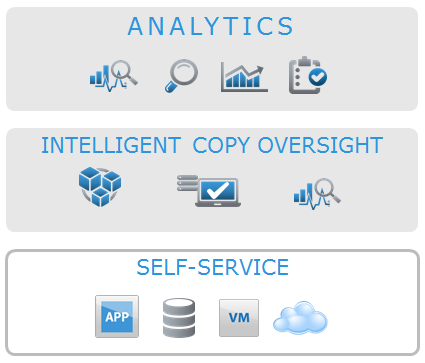When I think of technology buzzwords, I think of really big, complex concepts that slowly grow into all-encompassing terms to make those concepts easy to reference. Due to the complexity of some technology topics, however, buzzwords often create an opportunity for misconceptions. I’ve had people ask me if I work “for the cloud” when I talk about what I do, which is close – yet so far away.
In an earnest attempt to combat misconceptions, I want to discuss a term near and dear to my heart: modern data management. On the surface, it looks like this phrase implies that we want to manage data… modernly…? Well, that’s not wrong; but there’s a lot more behind this buzz-phrase.
First, we need to understand a broader trend in the industry: self-service. Basically, businesses no longer depend on IT to solve infrastructure problems due to the development of new technologies to enable increased agility. Before self-service, if an application administrator or DBA needed a copy of a production database, they would have to place a request to a storage or backup administrator and wait for the request to be fulfilled. Now, application owners and DBAs have easy access to copy creation tools from their native utilities, making it extremely easy to create copies themselves for any desired use case. Self-service is the foundation for modern data management.
While self-service is necessary to keep up with the demands of agile businesses, it raises some concerns. Specifically, if application owners and DBAs are managing their own copies, how can managers enforce a specific set of rules or policies to ensure compliance with business objectives, such as protection SLAs or retention policies? This trend towards self-service has led to siloes of storage managed by decentralized teams, making it difficult for IT managers and protection administrators to monitor their copy ecosystem and ensure service level agreement (SLA) compliance.
Moreover, native utilities have no way to monitor or enforce SLAs or protection policies. Copy creation tools simply relay that the copy was created successfully. Even if application, database, and backup administrators create copies to align with protection SLAs, they can’t be expected to constantly check the environment to ensure that nothing has happened to those copies. Administrators are left to assume that their copies are sitting healthy on storage, even though they could be missing their SLAs.
Ok, so how does modern data management solve these problems? Well, modern data management provides a comprehensive view of data generated in the modern enterprise to enable SLA-based copy data lifecycle management, thus ensuring enterprise compliance and security. In order to fulfill this mission, modern data management consists of two additional components that build on self-service: intelligent copy oversight and analytics.

Intelligent copy oversight, such as Dell Enterprise Copy Data Management, provides managers with a view of all copies in a data center. This component allows managers to create SLOs and apply them to protectable storage assets. Then, copies of assets will be continually monitored for compliance, and SLA enforcement can be automated to ensure compliance with business objectives. With intelligent copy oversight, managers will have a clear way to view and manage their copy ecosystem.
Analytics, such as Dell Enterprise Copy Data Analytics, ensures that managers can view global SLA compliance of copy data while also providing insight into the health and optimization of protection infrastructure. These insights will facilitate proactive infrastructure management to further reduce storage costs.
Together, intelligent copy oversight and analytics encourage self-service workflows by enabling managers to oversee data protection environments. Managers can see exactly how many copies exist, they can enforce SLAs, they can ensure that they’re meeting SLAs even after initial copy creation, and they have the tools to further optimize their infrastructure.
With these components supporting self-service, it’s pretty clear to see that modern data management defines the future of data protection. Now, next time your friend tries to tell you that modern data management is about “managing data… modernly,” you can explain that they’re close – yet so far away.